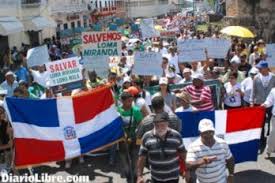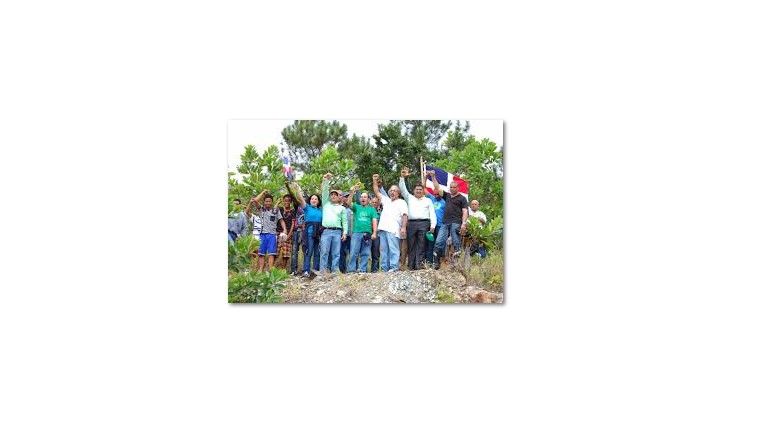In La Vega, Dominican Republic, a grassroots campaign has been demonstrating for a declaration that Loma Mirada hill become a National Park. Last week, Salesian priest Rogelio Cruz–who has led the months-long for a park to be created on the site of Glencore Falcondo’s planned nickel mine–led a march of hundreds of Dominicans from La Vega towards the site’s still-militarized main entrance.
In this testimony, a Dominican lets us understand the life and history of the people and the mine in the changing times.
With the Spanish colony, it was the gold and silver rush, until there was no more and half the Taínos had died or left the place.
Then nothing for a long time… half dead villages waiting for the next attack from corsairs and pirates. The mother country didn’t give a damn for a long time, not even importing slaves (like next door Haiti) to liven things up, work them dead and make money. A long slump into oblivion, until the big stick, Marine occupation, road building, political authority, taxes, law and order and the long Trujillo “get off your ass or else” period… the “or else” had a meaning.
A long slump into oblivion, until the big stick, Marine occupation, road building, political authority, taxes, law and order and the long Trujillo “get off your ass or else” period… the “or else” had a meaning.
Then sugar. The South Puerto Rico Sugar Company changed the landscape. The Eastern prairies were levelled overnight and money was made a plenty, the sugar “boom” had arrived.
The ladies in towns like San Pedro de Macorís went on shopping trips to Paris and the kids studied at the Sorbonne.
Cuba was the big competitor, but had its run in with Spain and ended up American. Wars are obstacles to good business.
After Trujillo the sugar fields were abandoned, the land was was divided up into properties destined for the new enterprises: cattle, great herds which gave major investment returns and political clout.
But Quisqueya (native name) had a hidden treasure, like a good looking girl under her skirt: minerals!!!
In the Southern coast bauxite was discovered and the U.S. company Alcoa mined it through the ’80s.
After Alcoa left the operation, SIierra Bauxita Dominican has a running operation extracting not only bauxite but clinker, limestone, bauxite and concrete.
By 1955 the mining wake up call, with Trujillo still around, a permit was extended for the exploration of mineral wealth to Minera y Beneficiadora Dominicana S. A. for 79,000 hectares.
Just a year later the contract as granted to the Canadian multinational FALCONBRIDGE, a mighty worldwide nickel operator in December of 1956 for the exploitation of the mineral around the hills surrounding the town of Monseñor Nouel (Bonao).
It was a prosperous time: half the town was somehow employed by the company, the rest had business with it.
The whole mining industry was getting red hot. During the 70’s and later, into current times as is usual, mining got into peoples’ guts, realizing the damage that was being caused to the environment in water and river pollution, rising rates of diseases, periodic shutdowns due to crashed international prices, etc.
Around the town of Bonao, which had technically prospered during many years from the presence of Falconbridge which changed hands, sold to Xstrata toward the end of 2006, based in Switzerland.
But things were getting hot around Bonao and a rising tide of public demonstrations was overunning the country. Environmetal activists were organizing marches and sit-ins and putting pressure on Congress and President Medina.
The fact of the matter was that of all the “lomas” (hills), around Bonao which had been esploited in depth over many years, there was just one left, Loma Miranda, that had become the focus of the struggle.
Now democracy had changed its tone from a vote every few years and then lethargy and just watching the politicians go about their bussines, to pressure groups demanding public attention to hundres or thousands of inefficent and corrupt deficiencies.
In August of 2014 Loma Miranda was declared a National Park by law, but on September 2, the law was objected by President Medina and returned to Congress citing certain deficiencies, but under public attack due to the suspicion the it had been under the influence of Falconbridge who was seeing its last bit of exploitable land whisked away by a bunch of activists, campesinos, ganged up and riotous clergy.
We may say the the sun baked, “mañana land”, banana planting and rice eating Dominicanos had at last woken up, like much of the current world situation, and was on the move to demand right and issues that had been dormant for so long.
ON THE MOVE!
By Joaquin Salazar
